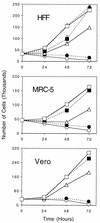Inhibition of cyclin-dependent kinase 1 by purines and pyrrolo[2,3-d]pyrimidines does not correlate with antiviral activity
- PMID: 12121920
- PMCID: PMC127371
- DOI: 10.1128/AAC.46.8.2470-2476.2002
Inhibition of cyclin-dependent kinase 1 by purines and pyrrolo[2,3-d]pyrimidines does not correlate with antiviral activity
Abstract
We have previously shown that a series of nonnucleoside pyrrolo[2,3-d]pyrimidines selectively inhibit the replication of herpes simplex virus type 1 (HSV-1) and human cytomegalovirus (HCMV). These compounds act at the immediate-early or early stage of HCMV replication and have antiviral properties somewhat similar to those of roscovitine and olomoucine, specific inhibitors of cyclin-dependent kinases (cdks). In the present study we examine the hypothesis that pyrrolo[2,3-d]pyrimidines exert their antiviral effects by inhibition of cellular cdks. Much higher concentrations of a panel of pyrrolo[2,3-d]pyrimidine nucleoside analogs with antiviral activity were required to inhibit recombinant cdk1/cyclin B compared to the submicromolar concentrations required to inhibit HCMV and HSV-1 replication. 4,6-Diamino-5-cyano-7-(2-phenylethyl)pyrrolo[2,3-d]pyrimidine (compound 1369) was the best inhibitor of cdk1 and cyclin B, with a 50% inhibitory concentration (IC(50); 14 microM) similar to that of roscovitine; it was competitive with respect to ATP (K(i) = 14 microM). The potency of compound 1369 against cdk1 and cyclin B was similar to its cytotoxicity (IC(50)s, 32 to 100 microM) but not its antiviral efficacy (IC(50)s, 0.02 to 0.3 microM). Thus, our results indicated the null hypothesis. In contrast, roscovitine was only weakly active against HSV-1 (IC(50), 38 microM) and HCMV (IC(50), 40 microM). These values were similar to those derived by cytotoxicity and cell growth inhibition assays, thereby suggesting that roscovitine is not a selective antiviral. Therefore, we propose that inhibition of cdk1 and cyclin B is not responsible for selective antiviral activity and that pyrrolo[2,3-d]pyrimidines constitute novel pharmacophores which compete with ATP to inhibit cdk1 and cyclin B.
Figures




Similar articles
-
Nonnucleoside pyrrolopyrimidines with a unique mechanism of action against human cytomegalovirus.Antimicrob Agents Chemother. 1999 Aug;43(8):1888-94. doi: 10.1128/AAC.43.8.1888. Antimicrob Agents Chemother. 1999. PMID: 10428908 Free PMC article.
-
Synthesis of non-nucleoside analogs of toyocamycin, sangivamycin, and ++thiosangivamycin: influence of various 7-substituents on antiviral activity.J Med Chem. 1996 Feb 16;39(4):873-80. doi: 10.1021/jm950444j. J Med Chem. 1996. PMID: 8632411
-
Synthesis and biological activity of olomoucine II.Bioorg Med Chem Lett. 2002 Nov 18;12(22):3283-6. doi: 10.1016/s0960-894x(02)00693-5. Bioorg Med Chem Lett. 2002. PMID: 12392733
-
Effects of pharmacological cyclin-dependent kinase inhibitors on viral transcription and replication.Biochim Biophys Acta. 2004 Mar 11;1697(1-2):197-209. doi: 10.1016/j.bbapap.2003.11.024. Biochim Biophys Acta. 2004. PMID: 15023361 Review.
-
Chemical and biological profile of dual Cdk1 and Cdk2 inhibitors.Curr Med Chem Anticancer Agents. 2003 Jan;3(1):1-14. doi: 10.2174/1568011033353605. Curr Med Chem Anticancer Agents. 2003. PMID: 12678910 Review.
Cited by
-
Cyclin-dependent kinase activity is required at early times for accurate processing and accumulation of the human cytomegalovirus UL122-123 and UL37 immediate-early transcripts and at later times for virus production.J Virol. 2004 Oct;78(20):11219-32. doi: 10.1128/JVI.78.20.11219-11232.2004. J Virol. 2004. PMID: 15452241 Free PMC article.
-
Roscovitine, a cyclin-dependent kinase inhibitor, prevents replication of varicella-zoster virus.J Virol. 2004 Mar;78(6):2853-62. doi: 10.1128/jvi.78.6.2853-2862.2004. J Virol. 2004. PMID: 14990704 Free PMC article.
-
Regulation of the retinoblastoma proteins by the human herpesviruses.Cell Div. 2009 Jan 15;4:1. doi: 10.1186/1747-1028-4-1. Cell Div. 2009. PMID: 19146698 Free PMC article.
-
CDK9 inhibitor FIT-039 prevents replication of multiple DNA viruses.J Clin Invest. 2014 Aug;124(8):3479-88. doi: 10.1172/JCI73805. Epub 2014 Jul 8. J Clin Invest. 2014. PMID: 25003190 Free PMC article.
-
Discovering new classes of Brugia malayi asparaginyl-tRNA synthetase inhibitors and relating specificity to conformational change.J Comput Aided Mol Des. 2006 Mar;20(3):159-78. doi: 10.1007/s10822-006-9043-5. Epub 2006 Apr 28. J Comput Aided Mol Des. 2006. PMID: 16645791
References
-
- Advani, S. J., R. Brandimarti, R. R. Weichselbaum, and B. Roizman. 2000. Disappearance of cyclins A and B and the increase in activity of G2/M-phase cellular kinase cdc2 in herpes simplex virus 1-infected cells require expression of the α22/US1.5 and UL13 viral genes. J. Virol. 74:8-15. - PMC - PubMed
-
- Alford, C. A., and W. J. Britt. 1993. Cytomegalovirus, p. 227-255. In B. Roizman, R. J. Whitley, and C. Lopez (ed.), The human herpesviruses. Raven Press, New York, N.Y.
-
- Breshnahan, W. E., I. Boldogh, E. A. Thompson, and T. Albrecht. 1996. Human cytomegalovirus inhibits cellular DNA synthesis and arrests productively infected cells in late G1. Virology 224:150-160. - PubMed
-
- Breshnahan, W. E., I. Boldogh, P. Chi, E. A. Thompson, and T. Albrecht. 1997. Inhibition of cellular cdk2 activity blocks human cytomegalovirus replication. Virology 231:239-247. - PubMed
-
- Breshnahan, W. E., E. A. Thompson, and T. Albrecht. 1997. Human cytomegalovirus infection results in altered cdk2 subcellular localization. J. Gen. Virol. 78:1993-1997. - PubMed
Publication types
MeSH terms
Substances
Grants and funding
LinkOut - more resources
Full Text Sources
Miscellaneous

